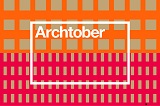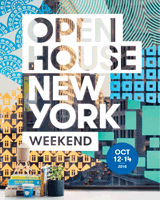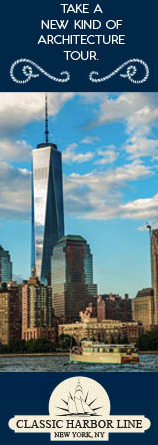
Today’s News - Thursday, October 4, 2018
EDITOR'S NOTE: We're a bit short on news and long on diversions today - the technology gods have not been kind to us this week. Meanwhile, tomorrow and Monday will be no-newsletter days. We'll be back Tuesday, October 9 (with friendlier gods, we hope!).
● ANN feature: Taylor's third and final Venice in Three Parts: There are treasures and treats to be found beyond the confines of the Giardini della Biennale.
● Filler weighs in on Venturi, the "visionary mannerist of main street - he and Denise Scott Brown's "support of a more egalitarian, inclusive approach to high-style architecture might have been their most important accomplishment."
● Azaroff explains how "collaboration is key in helping New York [and elsewhere] to advance its sustainability and resilient policies": City agencies and officials "have learned a lot from architects," but "have these attitudes proliferated to the next generation of leaders and architects? That, I'm not sure about. I hope that it does."
● Call for entries (deadline looms!): WinterStations 2019: "Migration": international competition to bring temporary public art installations/lifeguard stands to The Beaches in Toronto (one of our faves).
Weekend diversions:
● Keller offers "not-to-miss happenings" during NYC's Archtober 2018: "From pumpkin-carving contests to talks on women in design, there's something for everyone."
● John Cary curates "Design for Good: Architecture for Everyone" at the Museum of Design Atlanta.
● Q&A with Cary re: "Design for Good" at MODA: He discusses "the many ways design shapes our lived experience, even if we don't realize it."
● Wainwright parses "Living With Buildings" at the Wellcome Collection in London: The "history of architects' efforts to make our lives fitter by design is both fascinating and alarming" - but the show "is an odd mix that sometimes feels like it wants to be more of an exhibition about housing and the ills of gentrification than a focused investigation into how architects have tackled health."
● Housing advocate Robbins minces no words re: "Renzo Piano: The Art of Making Buildings" at London's Royal Academy: The show is "a love-in for the cultural establishment" that "perpetuates the view of design as a benign social abstraction. At a time when 80 London council estates are threatened with demolition, a more critical view is needed."
● Frearson, on a brighter note, parses the centerpiece of the Piano show - a fictional metropolitan island with 102 of RPBW's projects, complete with roads, mountains and trees (and Piano-designed boats).
● In Winterthur, Switzerland, ETH Zurich "creates an outdoor pavilion using nothing more than 30 tons of loose stones, 120 kilometers (about 75 miles) of string, and a construction robot," part of "Hello, Robot. Design between Human and Machine" at the Gewerbemuseum.
● Campbell-Dollaghan thinks "the best James Turrell skyspace is the one you can ski to" in Lech, Austria, which includes a movable ceiling and a 45-foot-long tunnel offering "a view of the region's most prominent mountains."
● The traveling "Place, Culture, Time - Design in Drastically Changing China" lands at UC Berkeley, presenting the "remarkable practices of He Jingtang and his team" with the aim "to bridge over the east and west and promote dialogue and communication between the two countries."
Page-turners:
● Frank cheers Filler's "Makers of Modern Architecture, Volume III" in which he "lyrically recounts" the "stories about individuals both liked or strongly disparaged."
● Tarmy cheers "Atlas of Brutalist Architecture," a new encyclopedia of brutalist buildings that "makes the case that the movement is mounting a comeback - renewed attention translated into conservation efforts - thanks to Instagram" (great pix!).
● Urbach hails Segal's "Space Packed: The Architecture of Alfred Neumann" that "follows the rise and fall of Israel's unsung architect - and convincingly asserts that this man at the margins was ahead of the times" (and "lavishly illustrated").
● Hall Kaplan hails the Riches' "Mod Mirage," an "unabashed appreciation for the architectural style and affection for Rancho Mirage" that "makes for a coffee table must for Midcentury fans."
● Fusselman cheers Lange's "The Design of Childhood": "We are lucky to have a writer like Lange putting children's environments into context, to help us see the responsibility we bear, and to make better decisions about what and how we build for children in the future."
● Carpenter, Donoff, and Deean parse positively Lange's "The Design of Childhood," Sorkin's "What Goes Up: The Right and Wrongs to the City," and Frederick & Mehta's "101 Things I Learned in Urban Design School."
● Welton waxes almost poetic about Harmon's "Native Places: Drawing as a Way to See," a "series of words [and drawings] held together with depth and dexterity - his instincts are spot-on. And now we have the book to prove it."
| |





|
|
|
To subscribe to the free daily newsletter
click here
|
ANN feature: Julie D. Taylor: Venice in Three Parts - Part 3: There are treasures and treats to be found beyond the confines of the Giardini della Biennale. [images]- ArchNewsNow.com |
Martin Filler: Robert Venturi: Visionary Mannerist of Main Street: ...[in] "Makers of Modern Architecture...I had revised my original opening...reflected my gradual understanding that Denise Scott Brown...had been given far too little credit in their partnership...the two were, in fact, responsible for several of the most singular buildings of our time...Their support of a more egalitarian, inclusive approach to high-style architecture might have been their most important accomplishment.- New York Review of Books |
Illya Azaroff: Creating a Blueprint for Better: Collaboration is key in helping New York to advance its sustainability and resilient policies: Following Superstorm Sandy, the idea of information sharing became second nature to everyone. Those strong bonds, threads, and bridges...still exist today. As architects, our open, collaborative nature became infectious, with agencies and officials...They’ve learned a lot from architects...have these attitudes proliferated to the next generation of leaders and architects? That, I’m not sure about. I hope that it does... (as told to Caitlin Reagan) -- +LAB; FLASH- AIArchitect / American Institute of Architects |
Call for entries: WinterStations 2019: "Migration": international design competition to bring temporary public art installations/6 lifeguard stands to The Beaches in Toronto for exhibition February - April 2019; cash prizes; deadline: October 22- Winter Stations (Toronto, Canada) |
Hadley Keller: What Not to Miss at Archtober 2018: From pumpkin-carving contests to talks on women in design, there's something for everyone at this monthlong festival: Organized by the Center for Architecture and now in its eighth year, the festival provides an umbrella for events, lectures, exhibitions, and other programming throughout New York's five boroughs all month long.- Architectural Digest |
New Museum of Design Atlanta [MODA] Exhibit Celebrates Architecture That Dignifies: John Cary curates "Design for Good: Architecture for Everyone" based on his latest book on people-centric architecture. thru January 20, 2019 -- Sharon Davis Design/Women for Women International; BcWorkshop; David Baker Architects; Michael Maltzan Architecture; Studio Gang; MASS Design Group; Orkidstudio [images]- Architect Magazine |
Q&A: John Cary’s “Design for Good” at MODA shows how great design can uplift: ...[he discusses] the many ways design shapes our lived experience, even if we don’t realize it: How does architecture fulfill a social justice function? ..."particularly marginalized people and communities that are all too often relegated to the worst of design. When design is truly dignifying, it can make people feel honored, respected, safe and seen."- ArtsATL (Atlanta) |
Oliver Wainwright: "Living With Buildings": prescriptions for healthier design: From sleek sanatoriums and concrete clinics ... to plywood boxes. This history of architects’ efforts to make our lives fitter by design is both fascinating and alarming: There is plenty of fascinating material, but it’s an odd mix that sometimes feels like it wants to be more of an exhibition about housing and the ills of gentrification than a focused investigation into how architects have tackled health. Wellcome Collection, London, thru March 3, 2019 [images]- Guardian (UK) |
Glyn Robbins: Towering architectural feats? Piano fails to hit the right note: Renzo Piano has made a successful career out of designing buildings that ordinary people are largely excluded from using: "Renzo Piano: The Art of Making Buildings" is a love-in for the cultural establishment...perpetuates the view of design as a benign social abstraction in which architects are neutral from the social processes which shape - and are shaped by - their work. At a time when 80 London council estates are threatened with demolition, a more critical view is needed... Royal Academy of Arts thru January 20, 2019- Socialist Worker (UK) |
Amy Frearson: Renzo Piano's studio designs "imaginary island" containing 102 of the architect's projects: ...the centrepiece of "Renzo Piano: The Art of Making Buildings"...a fictional metropolis, complete with roads, mountains and trees...show offers a detailed look at 16 of his most important buildings. Royal Academy of Arts, London, thru January 20, 2019 [images]- Dezeen |
"Rock Print Pavilion: A robot builds for people": ETH Zurich creates an outdoor pavilion using nothing more than 30 tons of loose stones, 120 kilometers (about 75 miles) of string, and a construction robot. The temporary installation in front of the Gewerbemuseum in Winterthur, Switzerland...part of the “Hello, Robot. Design between Human and Machine” exhibition; thru November 4 -- Gramazio Kohler [images]- ETH Zurich |
Kelsey Campbell-Dollaghan: The best James Turrell skyspace is the one you can ski to: The artist’s latest light work opened in Lech, Austria: Unlike most of his skyspaces...this latest structure has a movable ceiling. It’s a necessity in a town that can get 90 inches of snow...Visitors access it through a 45-foot-long tunnel, and once they’re inside, they can turn around to see one of the region’s most prominent mountains... [images]- Fast Company / Co.Design |
“Place, Culture, Time - Design in Drastically Changing China” He Jingtang Architecture Exhibition Debut in USA: ...has toured around China...Now at...UC Berkeley, the exhibition aims to bridge over the east and west and promote dialogue and communication between the two countries...presents the enriched contents of different architectural typologies...as well as the remarkable professional practices of He Jingtang and his team. thru October 21 [images]- University of California, Berkeley |
Suzanne Frank: Martin Filler lyrically recounts the luminaries of modern architecture: "Makers of Modern Architecture, Volume III: From Antoni Gaudí to Maya Lin" is as moving as the other two editions in the series: not only are his portraits individualized, but their particularities are given broad and vast depth in history...smoothly telling stories about individuals both liked or strongly disparaged...- The Architect's Newspaper |
James Tarmy: Much-Reviled Architectural Style Trending Again, Thanks to Instagram: A new encyclopedia of brutalist buildings makes the case that the movement is mounting a comeback: "Atlas of Brutalist Architecture," a compilation of 878 brutalist buildings in more than 100 countries illustrated by more than 1,000 photographs...even before the movement was declared dead, brutalist buildings were being ripped down...around five years ago, there was a sea change...The genesis, Virginia McLeod says, was Instagram...renewed attention translated into conservation efforts. -- Bertrand Goldberg; School, Zvi Hecker/Alfred Neumann/Mitzpe Ramon; Eero Saarinen; Jørn Utzon; Kevin Roche John Dinkeloo; Robert Matthew Johnson-Marshall & Partners; Steven Holl Architects; Oscar Grigorievich Havkin; Charles Correa; Charles Wright Architects [images]- Bloomberg News |
Henry Urbach: Rafi Segal’s "Space Packed: The Architecture of Alfred Neumann" follows the rise and fall of Israel’s unsung architect: In addition to providing a compelling biography, Segal makes the claim for Neumann’s unique significance and demonstrates how his work captured important conversations and conflicts in Israeli architecture of the 1950s and ’60s...Lavishly illustrated...convincingly asserts that this man at the margins was ahead of the times.- The Architect's Newspaper |
Sam Hall Kaplan: Mid-Century Modern Architecture and a City Celebrated: “Mod Mirage”: Written by preservationist Melissa Riche and resplendently photographed by Jim Riche, the book’s focus is the singular desert city of Rancho Mirage...The unabashed appreciation for the architectural style and affection for Rancho Mirage by the book’s author wife and photographer husband makes for a coffee table must for Midcentury fans...Kudos for all who have rallied to preserve the distinctively styled architecture...and also to Melissa and Jim Riche for faithfully documenting the history.- City Observed |
Amy Fusselman: Alexandra Lange Explores the Design of Childhood: The critic extracts the cultural significance of toys, furniture, and environments designed for kids - and in the process, examines childhood itself: ...we are lucky to have a writer like Lange putting children’s environments into context, to help us see the responsibility we bear, and to make better decisions about what and how we build for children in the future.- Metropolis Magazine |
Polly Carpenter: "The Design of Childhood" by Alexandra Lange: The cardboard box gets top billing...and for good reason. It is the perfect child’s toy...{She] does not shy from examining racial inequity. Elizabeth Donoff: "What Goes Up: The Right and Wrongs to the City" by Michael Sorkin: His ability to decipher the nuances of the urban condition is on full display...Those already familiar with his no-holds-barred approach to commentary will not be disappointed. Meera Deean: "101 Things I Learned in Urban Design School" by Matthew Frederick & Vikas Mehta: ...a good reminder that much of what we, as designers, take as self evident can be new to those not steeped in urban design.- ArchitectureBoston (Boston Society of Architects/BSA) |
J. Michael Welton: Architect’s signature drawings go beyond art. They tell stories of the world around us: Frank Harmon sketches...in a style that’s best described as economical...64 of his drawings, with equally thoughtful essays...[in] “Native Places: Drawing as a Way to See"...Over time, his drawings have become his signature...The essays [are] not poetry, but a series of words held together with depth and dexterity...The net effect is a marriage of thought and language that yields more than the sum of its parts....Honed to near-perfection over seven decades, his instincts are spot-on. And now we have the book to prove it.- News & Observer (North Carolina) |
ANN feature: Julie D. Taylor: Venice in Three Parts - Part 2: There are three distinct types of displays at this year's La Biennale di Venezia: immersive experiences, artistic expressions, and marketing efforts. Guess which are most satisfying? [images]- ArchNewsNow.com |
ANN feature: Julie D. Taylor: Venice in Three Parts - Part 1: As a first-timer to La Biennale di Venezia, I was awed, delighted, and enchanted at the spectacle of architecture in so many expressions.- ArchNewsNow.com |
|
|
Note: Pages will open in a new browser window.
External news links are not endorsed by ArchNewsNow.com.
Free registration may be required on some sites.
Some pages may expire after a few days.
© 2018 ArchNewsNow.com


